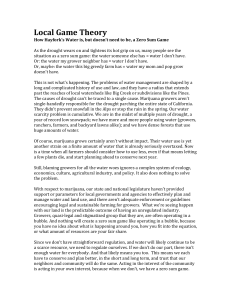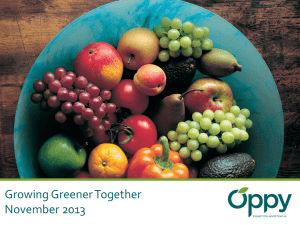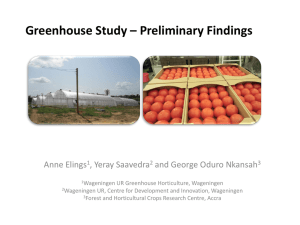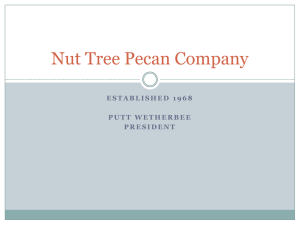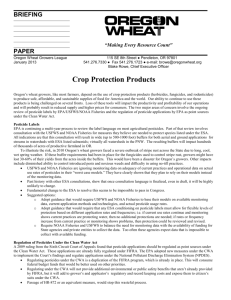History of Pioneer Valley Growers
advertisement
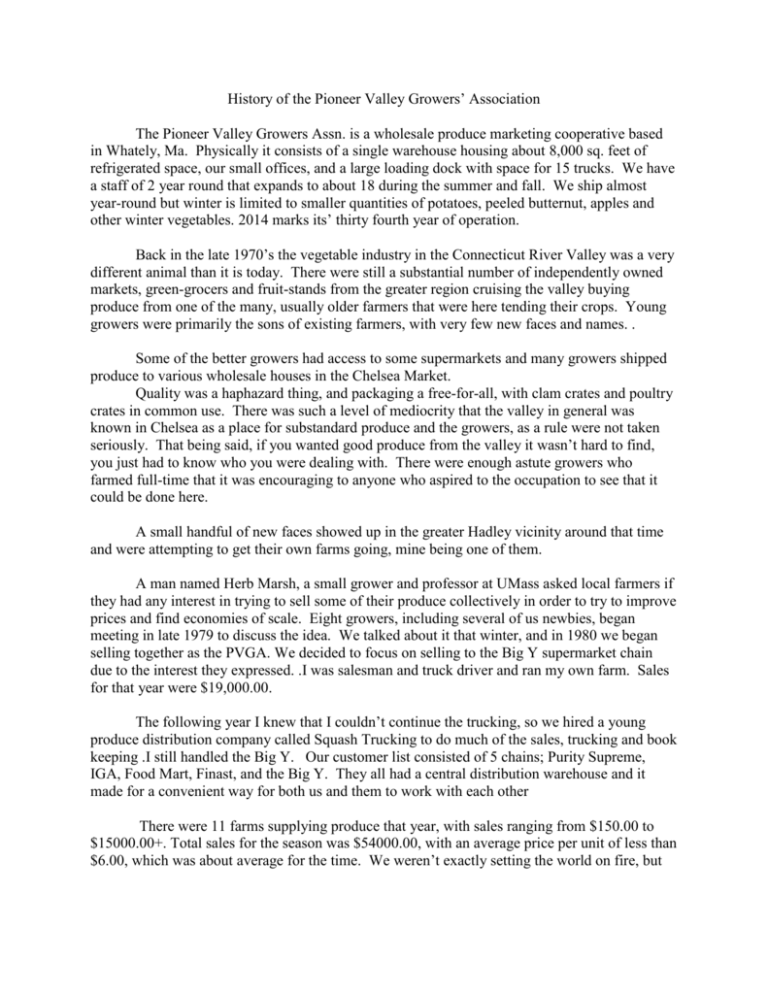
History of the Pioneer Valley Growers’ Association The Pioneer Valley Growers Assn. is a wholesale produce marketing cooperative based in Whately, Ma. Physically it consists of a single warehouse housing about 8,000 sq. feet of refrigerated space, our small offices, and a large loading dock with space for 15 trucks. We have a staff of 2 year round that expands to about 18 during the summer and fall. We ship almost year-round but winter is limited to smaller quantities of potatoes, peeled butternut, apples and other winter vegetables. 2014 marks its’ thirty fourth year of operation. Back in the late 1970’s the vegetable industry in the Connecticut River Valley was a very different animal than it is today. There were still a substantial number of independently owned markets, green-grocers and fruit-stands from the greater region cruising the valley buying produce from one of the many, usually older farmers that were here tending their crops. Young growers were primarily the sons of existing farmers, with very few new faces and names. . Some of the better growers had access to some supermarkets and many growers shipped produce to various wholesale houses in the Chelsea Market. Quality was a haphazard thing, and packaging a free-for-all, with clam crates and poultry crates in common use. There was such a level of mediocrity that the valley in general was known in Chelsea as a place for substandard produce and the growers, as a rule were not taken seriously. That being said, if you wanted good produce from the valley it wasn’t hard to find, you just had to know who you were dealing with. There were enough astute growers who farmed full-time that it was encouraging to anyone who aspired to the occupation to see that it could be done here. A small handful of new faces showed up in the greater Hadley vicinity around that time and were attempting to get their own farms going, mine being one of them. A man named Herb Marsh, a small grower and professor at UMass asked local farmers if they had any interest in trying to sell some of their produce collectively in order to try to improve prices and find economies of scale. Eight growers, including several of us newbies, began meeting in late 1979 to discuss the idea. We talked about it that winter, and in 1980 we began selling together as the PVGA. We decided to focus on selling to the Big Y supermarket chain due to the interest they expressed. .I was salesman and truck driver and ran my own farm. Sales for that year were $19,000.00. The following year I knew that I couldn’t continue the trucking, so we hired a young produce distribution company called Squash Trucking to do much of the sales, trucking and book keeping .I still handled the Big Y. Our customer list consisted of 5 chains; Purity Supreme, IGA, Food Mart, Finast, and the Big Y. They all had a central distribution warehouse and it made for a convenient way for both us and them to work with each other There were 11 farms supplying produce that year, with sales ranging from $150.00 to $15000.00+. Total sales for the season was $54000.00, with an average price per unit of less than $6.00, which was about average for the time. We weren’t exactly setting the world on fire, but we were encouraged by the deliveries to the central warehouses, not so much by store deliveries due to the vast amount of time spent getting it there. We deducted 5% plus trucking from grower checks to cover expenses. We were lucky to have the folks from Squash willing to do the work in the first place, but to do it as reasonably as they did and with such a high level of interest in our success was truly a gift from good friends. Sales grew relatively quickly as we got a sense of what our customers expected of us, with sales quadrupling the following year and more than doubling in 1983. That was the year we legally became a cooperative. To attract new farms we allowed potential growers to get a feeling for us by shipping as non-members, with a slightly higher commission charge. It was interesting to note that among a few of the chain buyers there was an expressed dislike of our organization. They felt we were getting “uppity” by organizing. They had nothing to fear because our strategy was to do as good a job as we could so we might see somewhat better prices and become preferred contacts. Most of their griping I know was psychobabble because they practiced the art constantly on us, pressuring us for low prices. By 1985 we were in Squash’s way so we leased the warehouse that we currently own and we hired a young man named Scott Danner for sales. Now with more overhead than ever we directed Scott to introduce himself to our customers, find new ones, secure new growers and see what this company could become. We paid him a salary plus a percentage on collected sales over a base amount, giving him the potential to earn some very decent money. He responded to the challenge in spades and the results were truly inspiring. He was greatly respected by our customers and sales grew almost faster than we could handle. Our membership ballooned to about 100 members, some from other states, and those of us that wanted to expand found the ability to do so. We had to hustle to turn most of the building into refrigerated space. It felt like we were finally retracting the landing gear and climbing rapidly to cruising altitude. Most of this was a direct result of Scott’s drive and attention to detail. Some of it was due to our growing reputation in the valley, but I will always believe that we hired the right person at the right time. Now the 7 member elected board of directors found themselves with a lot more coop than they were used to, and their decisions had a lot more impact on a lot more people. It was challenging but there was also a lot of enthusiasm. One of the primary challenges of the board was to set the growers’ commission rate high enough to cover expenses and low enough to keep them shipping. This is where we discovered that not all of our newfound members had the same level of faithfulness as the old guard did. For many we were a secondary “overflow” market and they used us when the price was right or the product too plentiful for their regular customers. We debated for years how to legislate loyalty and commitment, such as requiring a substantial cash buy-in for membership. That policy was never implemented though, and we were never really successful in getting loyalty by decree. Instead we tried to be creative with commission and freight charges. We offered growers the ability to deliver straight loads direct to the customers without stopping at our warehouse thus saving substantial money on trucking. We also offered declining commission rates at increasing sales volumes, looking for loyalty in the larger growers who were our bread and butter. We also began leasing a mobile vacuum cooler in order to do what most of the growers individually couldn’t; offer pre-cooled sweetcorn and other vegetables. It also took a huge burden off of our warehouse refrigeration systems by not having to deal with large amounts of hot corn and so maintained the quality of everything else that had to spend time in our coolers. Prior to pre-cooling, under the wrong conditions a trailer-load of corn could increase in temperature even with the Thermoking running at full throttle, until the corn lost quality and was seriously compromised. Produce quality was an issue that became more important and more of a problem as we got bigger. In the produce business there are relatively few factors that you have to get right if you expect to be a primary supplier. The top two are quality and dependability. We spent a lot of time educating growers and doing dock inspections. Some of them never got it. One of our past presidents unfortunately was in that category and it made for a big mess with respect to our customers and employee and member morale. I will never let that happen again if I have anything to say about it. 1. 2. 3. 4. 5. 6. 7. 1. 2. 3. 4. 5. 6. The requirements to become a member were reasonable: You needed to be sponsored by an existing member to be eligible A $200.00 fee got you a stock certificate. Sales to declared PVGA markets was forbidden. Some farms had to forfeit relationships with stores and was a factor in keeping some growers from joining. Uniform packaging for crops with multiple growers, such as corn, tomatoes, peppers, etc. was required. Adherence among growers of common products to pre-agreed upon packing standards was required. You had to provide written commitments of crops for the up-coming season. You needed to communicate with the salesman early and often beginning about 3 weeks away from harvest. The coop’s duties were: Meet with growers in the winter to advise on crops, varieties and volumes. Work with growers to achieve some consistency in common packs Negotiate with corrugated box manufacturers for cooperative buying of boxes Meet with customers preseason to assess our performance and their needs, put a face on the relationship and discuss marketing possibilities Advocate for local farms publically and politically Sell as much of the product offered as possible with the caveat that for each crop there was an agreed upon price floor below which the growers needed to approve the sale before the order could be accepted. That limited volume but it also set the tone with the chains that we weren’t the Vineland, NJ auction where $1.00 a box summer squash and zucchini could be had. It also, importantly, meant that the coop couldn’t promise to sell all products offered. That was a weak brick in our foundation, but we felt it necessary if we hoped for any long term increase in prices. Even now almost every year something, especially corn or squash will back up and we can’t sell it. We can almost always move it at a loss but it is the long-time and almost unanimous feeling from the growers over the years that they would rather not let it go too cheap, even in glut times. Right or wrong that was and is our directive unless told otherwise. The gluts happen fast, and even trying to anticipate them we’ll find our coolers plugging up with stuff often before we can alert the growers. Not only will the growers have to stop picking, they will likely not sell some part of what had been brought in. It’s always a lousy situation and all we can do sometimes is sympathetically listen to the growers gripe. The only way we’ve dealt with the situation has been to establish a fund to help pay for loads of good quality product that was rejected by the chains for no good reason and also to pay for product that was specifically ordered but not sold. You may wonder why we would even allow a customer to reject good quality product. As a rule we don’t, but they’re very good at rejecting something they don’t need, and if you have a USDA inspection done on the load you can expect to be last on the buyers list for some time after that. You have to assess each situation individually. I have to say that over the years one of the most aggravating realities has been the price of produce. If growers could have gotten on average an additional 15% for their produce, their profit margins would have skyrocketed and the coop would have been able to charge enough to pay for all of the things we needed to do without such reluctance from the growers. What made it doubly frustrating was seeing supermarket retail pricing jump from 50-100%of wholesale prices to 200% and more. So it seems that our original goal of getting better prices has not been achieved like we had hoped, but I believe that we helped stabilize prices by sticking to our guns regarding low prices and being dependable vendors. For many years we’ve been the primary vendors of several crops at several chains. One thing that was achieved was that several growers found opportunities to get larger and find certain economies of scale, and that is some degree of success for us. Looking back, I feel strongly that we were wrong in not hiring a general business manager. When we approached $2,000,000.00 in annual sales the board of directors, with their monthly meetings was too cumbersome to be really effective at day to day management during the shipping season. Lots of things were happening really fast and Scott had to be the de-facto manager. I also feel the board as a whole lacked the skills, expertise and imagination to keep the coop dynamic and fresh. Not to dismiss our abilities, but we were full-time farmers; we just didn’t have the time to give. I tried to push us into hiring a manager but the politics in the coop precluded that from happening, so to this day it is managed by the board. After Scott moved on it became obvious what an impact he’d had on the business. Sales slumped as a few large growers left for various reasons, and finding new growers meant reaching further and further away. We managed to increase sales over time but we found ourselves in the situation of being mature in the sense that, grower-wise, we had already picked the low-hanging fruit. There were only so many farmers nearby, and we basically had the ones we were going to get. We only hit the $3 million sales mark again twice and Scott left the year after hitting it the first time; I think he saw the handwriting on the wall. After Scott we went through a string of salespeople who didn’t last. One of them left us in a lurch; probably intimidated by a cooler full of summer squash and zucchini and no home for it. We were incredibly lucky to have a warehouse worker named Kurt Wolter able to take over the phones and get us through that season. Eventually we promoted our warehouse manager Bill Barrington to sales and we found the stability we needed. Our sales have been relatively flat for quite a few years now, but even so, the coop has been dependably selling about $2.5 million in produce every year for years which is still a lot of produce. The mix of crops we sell has evolved over time. We sold about 30 acres of leaf lettuces every spring in the early days. Poor prices and organic lettuce was its’ downfall. Bell peppers was a backbone of the organization for many years, with full loads going out daily. We must have had 100 acres or more per year go through our facility. Broadleaf tobacco and phytopthera dealt peppers out of the picture. Sweet corn was also dominant. Multiple loads went out nightly, and more loads went direct from the farms that we never had to touch. Corn is still a relatively big crop for us but nothing like it was. Lack of profitability drove corn growers out. As we speak there have been at least 4 large corn growers here and in the Hudson Valley that have shut their doors in the past year alone. Some were our customers. Now no crops dominate like in years past. My farm still moves a lot of collards and kale through the coop, as we have for over thirty years. The coop’s product mix is quite broad now, much more so than in earlier years. Nowadays, thanks in large part to our salesman Bill, our customer base has expanded to include much more than supermarkets. This, more than anything has led to somewhat better prices and is one of the coop’s strong suits. We also do some store to store deliveries when it is profitable to do so. It remains to be seen what the PVGA will morph into over time but it seems positioned to remain as a strong force in the region’s produce scene so long as there are wholesale growers who need us.
